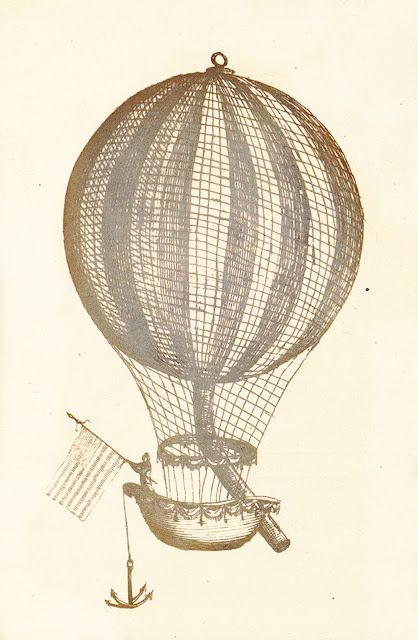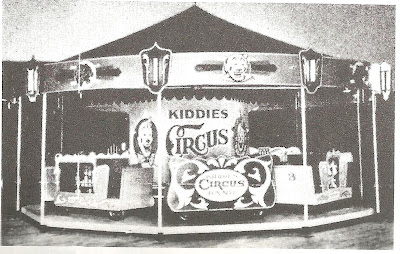Blanchard's Balloon Descent of 1793
History Revisited
History Revised
During my years as a historical researcher, I have come to realize some things. History is not always correct. Sometimes this is due to honest mistakes, like the misspelling of names, or poor recollection of dates and events. Many times these recollections are from the elderly who might have impaired memories. Other times they are result of hearsay or tall tales that should have no place in history books. Some historians engage in assumptions in order to complete their version of events. Sometimes these assumptions are based on logical conclusions when in the absence of historical proof, but other times they are based on nothing but wishful or convenient thinking. So sometimes history needs to be revisited especially when new or previously unconsidered information or evidence comes to light. Too often, mis-truths are repeated so often, that they become fact.
 |
| George Washington Looks On While Jean Pierre Blanchard Prepares To Ascend From The Yard Of The Walnut Street Prison, Philadelphia, PA January 9, 1793 |
It was January 9th 1793, and the celebrated French balloonist, Jean Pierre Blanchard, was about to ascend into the sky over Philadelphia. Thousands of people had gathered nearby and scores of dignitaries were on hand in the yard of the Walnut Street Prison, including President George Washington. Balloon flight was in its infancy, with the first maned flight occurring just 10 years earlier in France. This was to be the first in America.
 | |
| Jean Pierre Blanchard LINK - to more info on Jean Pierre Blanchard |
At 10:09 AM the tethers were released and the balloon rose over the city and was soon directed toward the south and east by a light wind. Before long Blanchard had crossed the Delaware River and was over South Jersey. He did keep a journal and brought various scientific instruments with him and recorded, direction, altitude, temperature and pressure. Soon after the flight Blanchard wrote and published
"Journal Of My Forty-Fifth Ascension Being The First Performed In America On The Ninth Of January 1793" which gave a somewhat detailed account of his flight. He recorded initially heading east towards the Delaware River but then southeast and then south-southeast - he rose high over the river and drifted towards South Jersey. He soon observed fog ahead of him and the wind increasing and decided it would be unsafe to try to land in fog and immediately started his descent.
He made three landing attempts. the first he aborted due to a large thick forest, the second because of jagged tree stumps, but on the third he found a clearing among some trees
"Journal Of My Forty-Fifth Ascension Being The First Performed In America On The Ninth Of January 1793" which gave a somewhat detailed account of his flight. He recorded initially heading east towards the Delaware River but then southeast and then south-southeast - he rose high over the river and drifted towards South Jersey. He soon observed fog ahead of him and the wind increasing and decided it would be unsafe to try to land in fog and immediately started his descent.
He made three landing attempts. the first he aborted due to a large thick forest, the second because of jagged tree stumps, but on the third he found a clearing among some trees
 | |
| Blanchard Flight Journal |
to readable Library Of Congress copy of Blanchard's Journal
After his 47 minute flight and while at a nearby house he had a document drawn up to be signed by witnesses of his descent and landing:
These may certify that we the subscribers saw the bearer, Mr Blanchard, settle in his balloon in Deptford township, county of Gloucester, in the state of New Jersey, about fifteen miles from Philadelphia, about 10 o'clock, 56 minutes, A.M. Witnessed our hands the ninth day of January, Anno Domini, 1793.
Everard Bolton
Joseph Griffith
Joseph Cheeseman
Samuel Taggart
Amos Castell
Zara North
There is little doubt that the balloon landed in Deptford Township, but there is nothing in Blanchard's journal that specifies the exact location. For the past 50 or so years the commemoration of the event has been near the historic Clement Oak which is located behind what is today
the Walmart at the Deptford Landing Shopping Center off Clements Bridge Rd. Memorial plaques were erected and ceremonies were held there in 1976 and 1993. But what historical evidence exist that pinpoints that location? I decide to find out.
I checked all available documents and files at the local libraries and historical societies and found nothing that records the exact landing place. For most of it's history the site was never specified, just given as "near Woodbury, NJ " Small ceremonies began in 1970 and 1976 the County and Township decided to commemorate the landing as part of the nation's bicentennial celebration and it was then that the Clement Oak site was chosen. The powers-that-be realized that the exact landing spot was unknown, but also realized the importance of preserving the story and the history of such an important event. Since the oak had already been recognized as historic landmark and thus likely to be preserved, it was decided to add the balloon landing to that site. It was even suggested that Blanchard might have used the large oak as a point of navigation. The oak is located directly on the bank of the wide Big Timber Creek and Blanchard would have avoided landing near water, plus he never mentions water when describing his landing.
But another factor, that had absolutely nothing to do with history or facts, was involved - the almighty dollar.
But another factor, that had absolutely nothing to do with history or facts, was involved - the almighty dollar.
In 1970's the owner of the land was the Radio Corporation of America (RCA), who operated a plant there. They saw an opportunity to tie their involvement in the Aerospace industry with the balloon celebration calling it the actual beginning of that industry in America. RCA donated towards the cost of the celebration, agreed to let the organizers use their land, and used the Balloon landing in some of their marketing materials.
So if the balloon did not land there, where did it land?
I went back to Blanchard's journal for some clues. He said that after he landed he was soon approached by "an inhabitant of the neighborhood" and then soon by another man and then followed by two woman and several men on horseback. Blanchard said he then went 200 yards to a small
house and then walked to a neighboring house. It was here where Blanchard had a certificate prepared that recorded the names of six witnesses to his descent. So perhaps these six could provide some clue to the location of the landing?
What I found is that three of the six witnesses lived within a half a mile of each other. Amos Cattell (not Castell) and Samuel Jaggard (not Taggart) lived along what is today Rt 41, Hurffville Rd in Almonesson, Deptford Township. Joseph Cheeseman lived just east of them on the other side of the
Big Timber Creek on Lower Landing Rd in Gloucester Township. Also two of the others Everard Bolton and Zara North were land owners in nearby Chews Landing.
Big Timber Creek on Lower Landing Rd in Gloucester Township. Also two of the others Everard Bolton and Zara North were land owners in nearby Chews Landing.
 |
| Cattell misspelled |
Cattell and Jaggard lived next door to each other. Were they the two men who approached Blanchard on foot right after he landed? Did Blanchard go to their homes afterward?
Cheesman, Bolton, Griffith and North would come from a greater distance and would have had to cross the Big Timber Creek. Were they the men who arrived later on horseback?
Perhaps we will never know, but I believe that a strong case could be made that the landing occurred near the homes of the
witnesses Jaggard and Cattell as they were the only two that actually lived in Deptford Township. It surely did not occur where the plaques were placed near the Clement Oak. It more likely occurred off of Rt 41 just south of the Deptford Mall.
witnesses Jaggard and Cattell as they were the only two that actually lived in Deptford Township. It surely did not occur where the plaques were placed near the Clement Oak. It more likely occurred off of Rt 41 just south of the Deptford Mall.
Some other info about the witnesses.
Samuel Jaggard's name was given as Taggert in Blanchard's Journal. I was unable to find a record of anyone of that name.
I found some antique maps that gave the names of residents and soon realized the name was misspelled.
Samuel Jaggard was 29 years old when the landing occured. The Jaggards were farmers who held large amounts of land in and around Almonesson, NJ He lived there all his life , born and died there. He was a neighbor of Amos Cattell.
 |
| The Grave of Samuel Jaggard and His Wife Hope at the old Jaggard Family Burial Grounds, RT 41, Almonesson, NJ. Several members of the Cattell family are also buried here. |
Amos Cattell of Almonesson was a younger brother of Jonas Cattell the famed revolutionary war hero who ran from Haddonfield to Red Bank to warn of a coming attack by the Hessians in 1777. Amos would have been 21 years old at the time of Blanchard's landing.
Everard Bolton was a Philadelphia merchant who did business and owned land and property in South Jersey, including a store in Chews Landing.
At the time of the landing he was 53 years old and married to Deborah Griscom Bolton, the sister of flag maker Betsy Ross. Deborah was 49 years old and died later that year from a yellow fever epidemic in Philadelphia. Were they one of the men and women who arrived on horseback?
Joseph Cheeseman was a member of the large Cheeseman clan of Gloucester Township. They also owned and operated several mills. Joseph was 38 years old at the time of the landing and living at Cheesman's Landing off Lower Landing Road near a wharf on the Big Timer Creek just across from Almonesson that was used to land boats and transfer merchant's goods.
Zara North - a resident of Chew's Landing in Gloucester Township. Was a member of the Church there. His descendants operated a store in Chews Landing for many years.
Joseph Griffith - A resident of Old Waterford Township ( Now Voorhees ) and age 36 at the time of the landing. Joseph came from a prominent and well to do family. His father was a county judge. So far I have unable to find any information as to why he was at the site of Blanchard's decent.
In his journal Blanchard says that after his landing his balloon and gondola were loaded into a cart and after stopping at the two above mentioned homes, he began to make his way back to Philadelphia. He says he traveled 3 miles to a tavern - this was likely the Buck Tavern in Westville. There he met up with a group of five"honest" citizens from Philadelphia including Jonathan Penrose and Robert Wharton who were wealthy Philadelphia landowners and members of the famed Gloucester Fox Hunting Club. At the tavern he was provided a carriage and traveled to a ferry, likely in Gloucester, where he crossed the Delaware at arrived at a point 3 miles south of the city.
 |
| National Gazette Newspaper January 12, 1793 |












































































